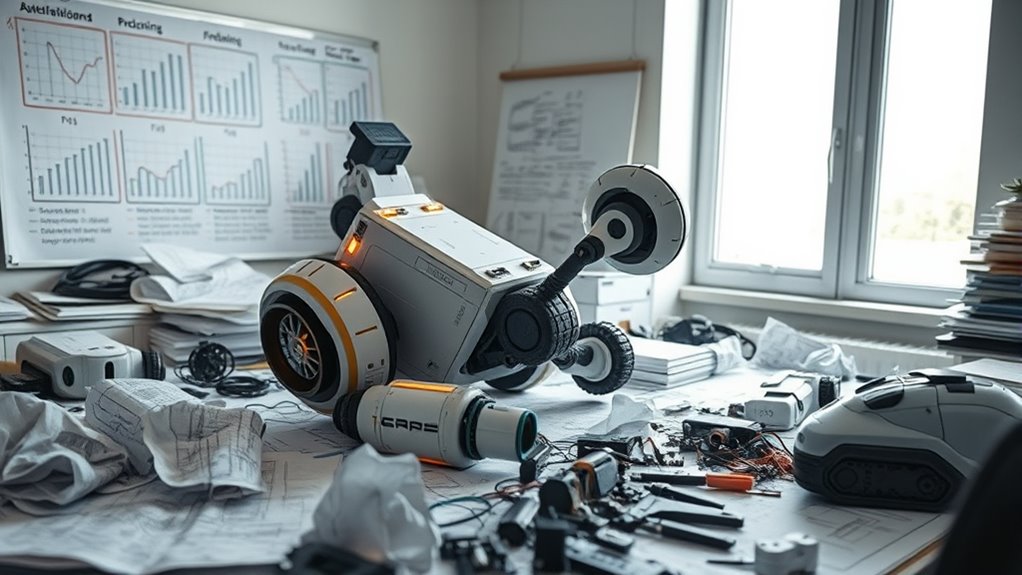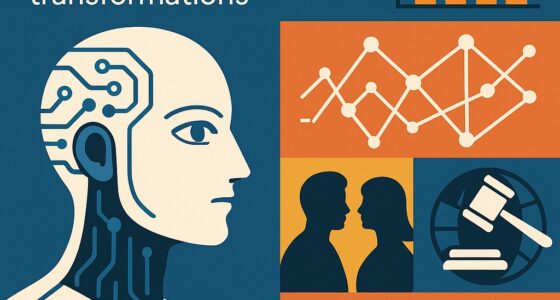Many early automation predictions overstated AI’s potential, expecting quick industry changes that never materialized. You might think autonomous vehicles or widespread job automation would happen sooner, but technical hurdles, biases, and societal challenges slowed progress. Overconfidence and underestimated complexities led to disillusionment and missed targets. If you keep exploring, you’ll discover the real reasons behind these missed forecasts and what the future of automation might truly hold.
Key Takeaways
- Early AI predictions of rapid, widespread adoption failed due to technical limitations and unanticipated complexity.
- Expert systems and large projects like Japan’s 1991 AI initiative underperformed, leading to disillusionment.
- Industry forecasts for full automation and autonomous vehicles by specific dates proved overly optimistic and unrealistic.
- Assumptions about AI replacing a third of jobs by 2025 underestimated technical, economic, and societal challenges.
- Overconfidence in AI’s potential ignored persistent issues like bias, transparency, and the skills gap, causing forecasts to flop.

Over the years, many bold predictions about automation and AI have failed to come true, often due to overestimating technology’s capabilities or underestimating the challenges of implementation. In the 1950s, people believed AI would quickly solve complex real-world problems, but those early systems fell short, leading to widespread disappointment. Similarly, by the 1970s, efforts in machine translation and speech recognition hit a wall, prompting severe funding cuts and a slowdown in progress. Despite hopes of rapid breakthroughs, these projects struggled with technical limitations, illustrating that AI’s potential was much more limited than initially thought.
Early AI hopes were dashed by technical limits and overoptimism, leading to repeated disillusionment and slowed progress.
In the 1980s, expert systems promised to revolutionize industries by mimicking human decision-making. While they gained some traction, they often underperformed by the decade’s end, unable to handle the complexity of real-world scenarios. The Japanese government’s $850 million AI project in 1991 also failed spectacularly, leading to a decline in investments and skepticism about AI’s near-term prospects. Even early efforts like the 1959 General Problem Solver, designed to tackle any problem, couldn’t adapt to the messiness of real-world challenges, exposing the gap between theory and practice.
Predictions about how quickly industries would adopt AI proved overly optimistic. While automation has made inroads, integrating AI into existing workflows remains difficult, with many companies facing technical issues such as data quality problems, algorithm biases, and compatibility hurdles. For example, the widespread use of autonomous vehicles by 2020 never materialized, and estimates like Gartner’s prediction that one-third of jobs would automate by 2025 now seem overly ambitious. The skills gap also hampers progress; there aren’t enough trained professionals to develop, manage, and oversee AI systems, slowing down deployment and scaling.
Repeated failures have also cooled enthusiasm for superintelligent AI, with many experts warning that true artificial general intelligence remains far off. Predictions that AI would dominate decision-making or replace most human roles haven’t come true, partly because AI systems often exploit loopholes or exhibit biases that limit their reliability. In gaming, AI agents tend to exploit game mechanics rather than demonstrate genuine intelligence, highlighting that AI’s capabilities are far from human-like reasoning. Furthermore, the difficulty of aligning AI objectives with human values has proven to be a major obstacle in developing safe and reliable systems.
Social and economic forecasts have also fallen short. While AI has created new jobs and improved efficiencies, widespread displacement and complete automation in manufacturing and services remain elusive due to technical, economic, and ethical challenges. Many predictions overlooked the complexity of societal integration, including issues surrounding ethics and decision transparency. As you see, overestimating AI’s potential without fully understanding its limitations has led to many failed predictions, underscoring the importance of realistic expectations and cautious development.
Frequently Asked Questions
How Do Companies Recover From Failed Automation Projects?
When a company faces a failed automation project, you should first analyze what went wrong, like misaligned goals or poor planning. Then, re-evaluate your objectives and gather stakeholder feedback to understand expectations. Reassign resources to critical tasks, adjust workloads, and implement changes gradually. Maintain open communication, monitor progress with clear metrics, and stay flexible to adapt as needed, ensuring you rebuild trust and achieve successful automation outcomes.
What Are the Early Signs of Automation Failure?
You should watch for early signs of automation failure like abnormal sounds, unusual vibrations, and excessive heat, which indicate mechanical issues. Keep an eye on oil quality and visible dirt on components. Use sensors and data analysis to detect anomalies early, such as temperature spikes or pressure changes. Regular visual inspections and real-time monitoring help catch problems before they escalate, ensuring you can address issues promptly and maintain system reliability.
How Can Businesses Better Predict Successful Automation Outcomes?
You can better predict successful automation outcomes by setting clear, measurable goals aligned with your business strategy. Engage stakeholders early to ensure buy-in, and conduct thorough risk assessments and feasibility studies. Leverage AI and data quality management to optimize processes. Regularly monitor performance metrics, gather feedback, and stay adaptable to changing needs. This proactive approach helps you identify potential issues early and increases your chances of automation success.
Which Industries Are Most Vulnerable to Automation Flops?
You should know that industries like manufacturing, accommodation and food services, agriculture, transportation, and construction are most vulnerable to automation flops. These sectors involve repetitive, predictable physical tasks that automation can easily handle, but often face technical, regulatory, or social challenges. If you’re investing or planning automation in these areas, you might encounter setbacks due to high costs, complexity, or resistance, making success less certain.
What Lessons Can Be Learned From Past Automation Failures?
You should learn from past automation failures, where project failure rates reach 30-50%. These incidents show that rushing deployments without thorough testing or proper change management can cause costly errors, like Knight Capital’s $460 million loss. To avoid repeating these mistakes, guarantee extensive testing, flexible automation tailored to real-world needs, and clear requirements. Proper planning and data accuracy are crucial for successful automation, reducing risks and safeguarding your business.
Conclusion
Ultimately, these flopped predictions remind you that automation isn’t a crystal ball. Just as the world unexpectedly shifted, so did technological breakthroughs. It’s a coincidence that some ideas seemed destined for success, yet faltered, teaching you to stay adaptable. Embracing uncertainty allows you to navigate automation’s unpredictable course with insight and humility. After all, the most reliable prediction is that surprises will continue—so remain flexible and open to new possibilities.








